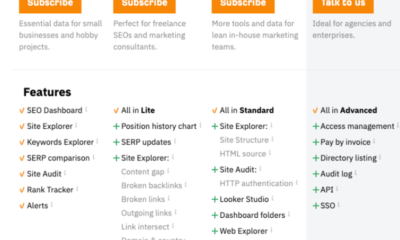Politics
15 Proven Ways to Increase Customer Engagement and Build Loyalty
Published
7 months agoon
By
Drew Simpson
Are you looking for ways to increase customer engagement? If so, you’re in the right place!
Engaging with your audience is one of the most important aspects of running a successful business. Not only does it create loyalty and trust between your company and your users, but it can also lead to increased sales and happier customers overall.
This post will discuss fifteen effective strategies that you can use to engage with your clients and build strong relationships with them. From creating meaningful conversations on social media to providing personalized experiences at every touchpoint, these strategies will help you make sure that your customers feel heard and appreciated (leading to greater success for your business)!
1. Social Media Engagement
One great way to engage with your clients is through social media.
You can use platforms like Twitter, Facebook, TikTok, and Instagram to start conversations, answer questions and show appreciation for customer feedback.
By engaging with your audience on social media, you can create an open dialogue that will help build trust in your company and ultimately lead to more sales.
2. Personalized Experiences
Providing personalized experiences can help people feel valued and more connected to your business.
You can do this by using data to create tailored offers, providing individualized customer service solutions or simply sending out special gifts or discounts for their birthdays.
Whatever you decide to do, make sure that you’re taking the time to make each client feel special and appreciated!
3. Customer Loyalty Programs
Creating loyalty programs is another great way to improve customer engagement and reward them.
Your loyalty program can include perks like exclusive discounts, free shipping, or early access to new products.
All of these will encourage people to keep coming back again and again.
4. Customer Management Software
Using customer management software can help you track customer engagement and ensure that everyone feels heard.
These tools can help you organize customer data, follow up on conversations or complaints quickly, and analyze customer behavior to understand what they’re looking for.
5. Community Building
Building a community around your brand is another great way to engage with your audience.
You can do this by hosting events, creating online forums, or simply offering clients a place to connect and share their experiences with each other.
By doing this, you’ll be building an engaged group of advocates that will help spread the word about your business.
6. Feedback Collection
Collecting feedback from your customers is essential for understanding how they feel about your products or services and what changes they would like you to make.
You can gather feedback through surveys, polls, or simply by asking them directly during conversations.
Taking the time to listen and respond to feedback is a great way to show them that you care about their opinions and will help build loyalty in the long run.
7. Online Reviews
Online reviews are one of the most powerful ways to engage with your clients.
Encouraging them to leave honest feedback about their experience can help you identify areas for improvement and create more personalized experiences for future customers.
You can also use online reviews as an effective way to promote your business, by highlighting positive customer testimonials on your website or social media channels.
By showing that you value customer feedback and responding to it in an appropriate manner, you’ll be able to create a positive reputation that will help drive more customers your way.
8. Customer Education
Educating your clients on how to use your products or services is another great way to increase engagement.
You can create helpful content, webinars, or even podcasts to make sure that users understand how to get the most out of what you’re offering.
This not only helps to increase engagement but also ensures that customers are using your products in the right way – leading to better experiences and more sales.
9. Gamification
Gamification is another great way to engage with customers and encourage them to interact with your business.
You can do this by creating competitions where customers can compete for rewards or give them points for completing certain tasks (like leaving reviews).
Whatever you decide to do, make sure that it’s fun and engaging so that people are encouraged to come back again and again.
10. Engage with Influencers
Influencer marketing is becoming increasingly popular and is a great way to reach more customers and increase engagement.
You can do this by collaborating with influencers in your industry who have their own loyal audiences of followers.
By partnering with the right celebrities, you will be able to tap into their network and reach a potential new audience that might not otherwise have heard about your business.
11. Utilize Automation
Using automation tools can help boost customer engagement.
Connect your website with automation tools to send out personalized messages or discounts based on user data or create automated campaigns that target specific customer segments for maximum engagement. If you don’t know how to do this, you can always hire backend developers.
Automation can also help monitor your audience feedback more effectively so that you can quickly respond and offer solutions when needed.
12. Offer Customer Support
Providing excellent customer support is key to any successful business – especially when it comes to engaging with customers.
Offering fast responses, easy-to-use help centers, and even live chat options are all great ways to ensure that clients feel supported and taken care of – leading to higher levels of engagement and loyalty in the long run.
13. Relevant Content
Creating relevant, high-quality content is another effective way to engage with customers and build trust in your brand.
This could include blog posts, newsletters or even videos – whatever works best for your audience!
Make sure that you’re providing content that adds value to their lives so that they’ll keep coming back for more.
14. Personalized Email Campaigns
Personalized emails are a great way to engage with clients and show them that you understand their individual needs.
You can do this by segmenting your email list and creating targeted campaigns based on customer data like location or purchase history.
This will make the content more relevant to each individual user, leading to higher engagement levels and more conversions.
15. Live Streaming Events
Live streaming events can be a great way to engage with your users in real-time and give them an inside look at your business.
You can stream product demos, Q&A sessions, or even webinars – all of which will help build trust in your brand and keep customers coming back for more.
Final Words
Engaging with customers is essential for any business – no matter the size or industry.
By following these tips, you’ll be able to increase engagement and create stronger relationships that will last in the long run.
So go ahead and start engaging today!
You may like
-


Chinese apps are letting public juries settle customer disputes
-


Four ways AI is making the power grid faster and more resilient
-


Customer experience horizons
-


The Download: teaching girls to build, and fixing government tech
-


Plastic is a climate change problem. There are ways to fix it.
-


Four Clever Ways to Use Tiered Pricing for Maximum Profit
Politics
Fintech Kennek raises $12.5M seed round to digitize lending
Published
7 months agoon
10/11/2023By
Drew Simpson
London-based fintech startup Kennek has raised $12.5 million in seed funding to expand its lending operating system.
According to an Oct. 10 tech.eu report, the round was led by HV Capital and included participation from Dutch Founders Fund, AlbionVC, FFVC, Plug & Play Ventures, and Syndicate One. Kennek offers software-as-a-service tools to help non-bank lenders streamline their operations using open banking, open finance, and payments.
The platform aims to automate time-consuming manual tasks and consolidate fragmented data to simplify lending. Xavier De Pauw, founder of Kennek said:
“Until kennek, lenders had to devote countless hours to menial operational tasks and deal with jumbled and hard-coded data – which makes every other part of lending a headache. As former lenders ourselves, we lived and breathed these frustrations, and built kennek to make them a thing of the past.”
The company said the latest funding round was oversubscribed and closed quickly despite the challenging fundraising environment. The new capital will be used to expand Kennek’s engineering team and strengthen its market position in the UK while exploring expansion into other European markets. Barbod Namini, Partner at lead investor HV Capital, commented on the investment:
“Kennek has developed an ambitious and genuinely unique proposition which we think can be the foundation of the entire alternative lending space. […] It is a complicated market and a solution that brings together all information and stakeholders onto a single platform is highly compelling for both lenders & the ecosystem as a whole.”
The fintech lending space has grown rapidly in recent years, but many lenders still rely on legacy systems and manual processes that limit efficiency and scalability. Kennek aims to leverage open banking and data integration to provide lenders with a more streamlined, automated lending experience.
The seed funding will allow the London-based startup to continue developing its platform and expanding its team to meet demand from non-bank lenders looking to digitize operations. Kennek’s focus on the UK and Europe also comes amid rising adoption of open banking and open finance in the regions.
Featured Image Credit: Photo from Kennek.io; Thank you!
Radek Zielinski
Radek Zielinski is an experienced technology and financial journalist with a passion for cybersecurity and futurology.
Politics
Fortune 500’s race for generative AI breakthroughs
Published
7 months agoon
10/11/2023By
Drew Simpson
As excitement around generative AI grows, Fortune 500 companies, including Goldman Sachs, are carefully examining the possible applications of this technology. A recent survey of U.S. executives indicated that 60% believe generative AI will substantially impact their businesses in the long term. However, they anticipate a one to two-year timeframe before implementing their initial solutions. This optimism stems from the potential of generative AI to revolutionize various aspects of businesses, from enhancing customer experiences to optimizing internal processes. In the short term, companies will likely focus on pilot projects and experimentation, gradually integrating generative AI into their operations as they witness its positive influence on efficiency and profitability.
Goldman Sachs’ Cautious Approach to Implementing Generative AI
In a recent interview, Goldman Sachs CIO Marco Argenti revealed that the firm has not yet implemented any generative AI use cases. Instead, the company focuses on experimentation and setting high standards before adopting the technology. Argenti recognized the desire for outcomes in areas like developer and operational efficiency but emphasized ensuring precision before putting experimental AI use cases into production.
According to Argenti, striking the right balance between driving innovation and maintaining accuracy is crucial for successfully integrating generative AI within the firm. Goldman Sachs intends to continue exploring this emerging technology’s potential benefits and applications while diligently assessing risks to ensure it meets the company’s stringent quality standards.
One possible application for Goldman Sachs is in software development, where the company has observed a 20-40% productivity increase during its trials. The goal is for 1,000 developers to utilize generative AI tools by year’s end. However, Argenti emphasized that a well-defined expectation of return on investment is necessary before fully integrating generative AI into production.
To achieve this, the company plans to implement a systematic and strategic approach to adopting generative AI, ensuring that it complements and enhances the skills of its developers. Additionally, Goldman Sachs intends to evaluate the long-term impact of generative AI on their software development processes and the overall quality of the applications being developed.
Goldman Sachs’ approach to AI implementation goes beyond merely executing models. The firm has created a platform encompassing technical, legal, and compliance assessments to filter out improper content and keep track of all interactions. This comprehensive system ensures seamless integration of artificial intelligence in operations while adhering to regulatory standards and maintaining client confidentiality. Moreover, the platform continuously improves and adapts its algorithms, allowing Goldman Sachs to stay at the forefront of technology and offer its clients the most efficient and secure services.
Featured Image Credit: Photo by Google DeepMind; Pexels; Thank you!
Deanna Ritchie
Managing Editor at ReadWrite
Deanna is the Managing Editor at ReadWrite. Previously she worked as the Editor in Chief for Startup Grind and has over 20+ years of experience in content management and content development.
Politics
UK seizes web3 opportunity simplifying crypto regulations
Published
7 months agoon
10/10/2023By
Drew Simpson
As Web3 companies increasingly consider leaving the United States due to regulatory ambiguity, the United Kingdom must simplify its cryptocurrency regulations to attract these businesses. The conservative think tank Policy Exchange recently released a report detailing ten suggestions for improving Web3 regulation in the country. Among the recommendations are reducing liability for token holders in decentralized autonomous organizations (DAOs) and encouraging the Financial Conduct Authority (FCA) to adopt alternative Know Your Customer (KYC) methodologies, such as digital identities and blockchain analytics tools. These suggestions aim to position the UK as a hub for Web3 innovation and attract blockchain-based businesses looking for a more conducive regulatory environment.
Streamlining Cryptocurrency Regulations for Innovation
To make it easier for emerging Web3 companies to navigate existing legal frameworks and contribute to the UK’s digital economy growth, the government must streamline cryptocurrency regulations and adopt forward-looking approaches. By making the regulatory landscape clear and straightforward, the UK can create an environment that fosters innovation, growth, and competitiveness in the global fintech industry.
The Policy Exchange report also recommends not weakening self-hosted wallets or treating proof-of-stake (PoS) services as financial services. This approach aims to protect the fundamental principles of decentralization and user autonomy while strongly emphasizing security and regulatory compliance. By doing so, the UK can nurture an environment that encourages innovation and the continued growth of blockchain technology.
Despite recent strict measures by UK authorities, such as His Majesty’s Treasury and the FCA, toward the digital assets sector, the proposed changes in the Policy Exchange report strive to make the UK a more attractive location for Web3 enterprises. By adopting these suggestions, the UK can demonstrate its commitment to fostering innovation in the rapidly evolving blockchain and cryptocurrency industries while ensuring a robust and transparent regulatory environment.
The ongoing uncertainty surrounding cryptocurrency regulations in various countries has prompted Web3 companies to explore alternative jurisdictions with more precise legal frameworks. As the United States grapples with regulatory ambiguity, the United Kingdom can position itself as a hub for Web3 innovation by simplifying and streamlining its cryptocurrency regulations.
Featured Image Credit: Photo by Jonathan Borba; Pexels; Thank you!
Deanna Ritchie
Managing Editor at ReadWrite
Deanna is the Managing Editor at ReadWrite. Previously she worked as the Editor in Chief for Startup Grind and has over 20+ years of experience in content management and content development.
